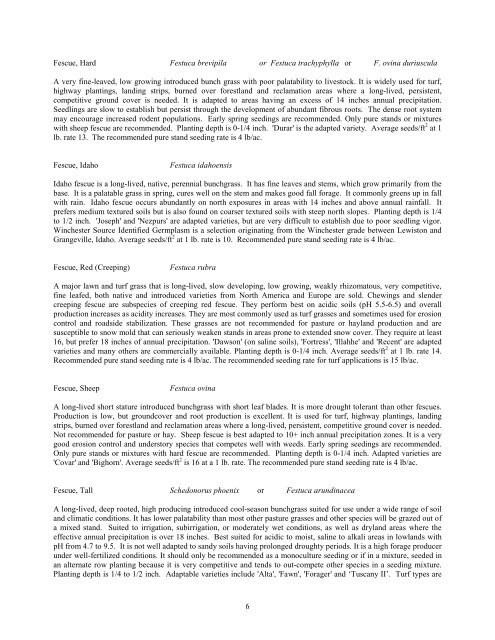Idaho Plant Materials Technical Note No. 24
Idaho Plant Materials Technical Note No. 24
Idaho Plant Materials Technical Note No. 24
You also want an ePaper? Increase the reach of your titles
YUMPU automatically turns print PDFs into web optimized ePapers that Google loves.
Fescue, Hard Festuca brevipila or Festuca trachyphylla or F. ovina duriuscula<br />
A very fine-leaved, low growing introduced bunch grass with poor palatability to livestock. It is widely used for turf,<br />
highway plantings, landing strips, burned over forestland and reclamation areas where a long-lived, persistent,<br />
competitive ground cover is needed. It is adapted to areas having an excess of 14 inches annual precipitation.<br />
Seedlings are slow to establish but persist through the development of abundant fibrous roots. The dense root system<br />
may encourage increased rodent populations. Early spring seedings are recommended. Only pure stands or mixtures<br />
with sheep fescue are recommended. <strong>Plant</strong>ing depth is 0-1/4 inch. 'Durar' is the adapted variety. Average seeds/ft 2 at 1<br />
lb. rate 13. The recommended pure stand seeding rate is 4 lb/ac.<br />
Fescue, <strong>Idaho</strong><br />
Festuca idahoensis<br />
<strong>Idaho</strong> fescue is a long-lived, native, perennial bunchgrass. It has fine leaves and stems, which grow primarily from the<br />
base. It is a palatable grass in spring, cures well on the stem and makes good fall forage. It commonly greens up in fall<br />
with rain. <strong>Idaho</strong> fescue occurs abundantly on north exposures in areas with 14 inches and above annual rainfall. It<br />
prefers medium textured soils but is also found on coarser textured soils with steep north slopes. <strong>Plant</strong>ing depth is 1/4<br />
to 1/2 inch. 'Joseph' and 'Nezpurs' are adapted varieties, but are very difficult to establish due to poor seedling vigor.<br />
Winchester Source Identified Germplasm is a selection originating from the Winchester grade between Lewiston and<br />
Grangeville, <strong>Idaho</strong>. Average seeds/ft 2 at 1 lb. rate is 10. Recommended pure stand seeding rate is 4 lb/ac.<br />
Fescue, Red (Creeping)<br />
Festuca rubra<br />
A major lawn and turf grass that is long-lived, slow developing, low growing, weakly rhizomatous, very competitive,<br />
fine leafed, both native and introduced varieties from <strong>No</strong>rth America and Europe are sold. Chewings and slender<br />
creeping fescue are subspecies of creeping red fescue. They perform best on acidic soils (pH 5.5-6.5) and overall<br />
production increases as acidity increases. They are most commonly used as turf grasses and sometimes used for erosion<br />
control and roadside stabilization. These grasses are not recommended for pasture or hayland production and are<br />
susceptible to snow mold that can seriously weaken stands in areas prone to extended snow cover. They require at least<br />
16, but prefer 18 inches of annual precipitation. 'Dawson' (on saline soils), 'Fortress', 'Illahhe' and 'Recent' are adapted<br />
varieties and many others are commercially available. <strong>Plant</strong>ing depth is 0-1/4 inch. Average seeds/ft 2 at 1 lb. rate 14.<br />
Recommended pure stand seeding rate is 4 lb/ac. The recommended seeding rate for turf applications is 15 lb/ac.<br />
Fescue, Sheep<br />
Festuca ovina<br />
A long-lived short stature introduced bunchgrass with short leaf blades. It is more drought tolerant than other fescues.<br />
Production is low, but groundcover and root production is excellent. It is used for turf, highway plantings, landing<br />
strips, burned over forestland and reclamation areas where a long-lived, persistent, competitive ground cover is needed.<br />
<strong>No</strong>t recommended for pasture or hay. Sheep fescue is best adapted to 10+ inch annual precipitation zones. It is a very<br />
good erosion control and understory species that competes well with weeds. Early spring seedings are recommended.<br />
Only pure stands or mixtures with hard fescue are recommended. <strong>Plant</strong>ing depth is 0-1/4 inch. Adapted varieties are<br />
'Covar' and 'Bighorn'. Average seeds/ft 2 is 16 at a 1 lb. rate. The recommended pure stand seeding rate is 4 lb/ac.<br />
Fescue, Tall Schedonorus phoenix or Festuca arundinacea<br />
A long-lived, deep rooted, high producing introduced cool-season bunchgrass suited for use under a wide range of soil<br />
and climatic conditions. It has lower palatability than most other pasture grasses and other species will be grazed out of<br />
a mixed stand. Suited to irrigation, subirrigation, or moderately wet conditions, as well as dryland areas where the<br />
effective annual precipitation is over 18 inches. Best suited for acidic to moist, saline to alkali areas in lowlands with<br />
pH from 4.7 to 9.5. It is not well adapted to sandy soils having prolonged droughty periods. It is a high forage producer<br />
under well-fertilized conditions. It should only be recommended as a monoculture seeding or if in a mixture, seeded in<br />
an alternate row planting because it is very competitive and tends to out-compete other species in a seeding mixture.<br />
<strong>Plant</strong>ing depth is 1/4 to 1/2 inch. Adaptable varieties include 'Alta', 'Fawn', 'Forager' and ‘Tuscany II’. Turf types are<br />
6
















